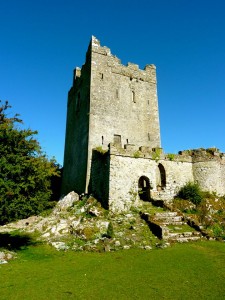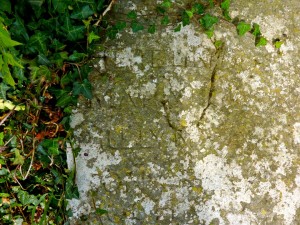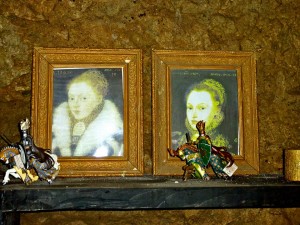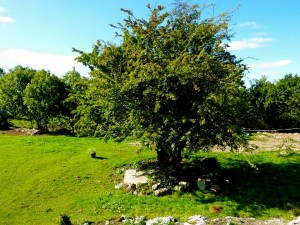
To celebrate St Patrick’s Day I tend to write about Anne Boleyn’s links to Ireland, but today I’m going to focus on the legend that links George Boleyn to Clonony Castle in County Offaly, Ireland, a castle that was built by the MacCoghlan clan in the early 1500s.
The following article is based on part of the appendix of George Boleyn: Poet, Courtier and Diplomat, the book that Clare Cherry and I will be releasing at the end of next month…
At the 1868 annual general meeting of the Historical and Archaeological Society of Ireland, in Kilkenny, a rubbing from the inscription on a tomb slab from Clonony Castle was examined. This slab was known locally as the monument of “Queen Elizabeth’s cousins” and read:
“HERE UNDER LEYS ELIZABETH AND MARY BULLYN DAUGHTERS OF THOMAS BULLYN SON OF GEORGE BULLYN THE SON OF GEORGE BULLYN VISCOUNT ROCHFORD SON OF SIR THOMAS BULLYN EARLE OF ORMONDE AND WILTSHIRE”

The slab was recorded as measuring seven feet by four feet, and being sixteen inches in thickness, and it was stated that it had been removed from a nearby quarry to the castle in the first quarter of the 19th century.1 Reference was then given to an article in “The Irish Penny Magazine” (September 1833) which told the story of the discovery of the tomb slab.2 According to the magazine article, labourers busy gathering stone for building work near Clonony Castle, in 1803, found a cave about a hundred yards from the castle. In the cave in the limestone rock, “about twelve feet under the surface” and beneath a pile of stones, they found a “large limestone flag” and “a coffin cut in the rock”, which contained the remains of two bodies. From the inscription on the limestone flag, these remains were identified as second cousins of Queen Elizabeth I, being great-granddaughters of George Boleyn, Lord Rochford.
The writer of the magazine article went on to ponder how these Boleyn girls ended up “interred in this obscure corner of the King’s county”, wondering if their father was employed in Ireland during the troubles in Elizabeth I’s reign or whether members of the Boleyn family fled from England to Ireland “to escape the fury of King Henry VIII” when Anne Boleyn and her brother fell in 1536. When the writer of the article shared the discovery of the tombstone with the Earl of Ross, who was descended through his mother from Alice, daughter of Sir William Boleyn of Blickling, the Earl showed him portraits of two young women at Birr Castle. Nobody knew who they were, but the paintings were marked “Anno aetatis 18” and “Anno aetatis 19” and “Anno Domini 1567″, meaning that the girls were in their 18th and 19th years when they were painted in 1567, and the Earl suggested that these were portraits of Elizabeth and Mary Boleyn. The portrait of the girl thought to be Mary pictured her with a marigold, for “Mary”, stuck behind an ear and the other girl was pictured wearing a jewel in the form of an “E” for Elizabeth. Both the Earl and the writer of the article became convinced that these girls were the Boleyn girls of the tomb. Birthdates of 1548 and 1547, however, make no sense if these girls are meant to be granddaughters of George Boleyn. Lady Rosse, the present owner of Birr Castle, believes the girls depicted in the portrait to be Margaret and Elizabeth Clere, daughters of John Clere of Ormesby St Margaret, Norfolk, who was the son of Robert Clere and Alice Boleyn, Anne Boleyn’s paternal aunt.3 The present Earl of Rosse descends from the Cleres through his great-great-great-great-grandmother, Mary Clere. When I researched the Cleres, I found that Margaret Clere married Walter Haddon (1514/1515-1571) and gave him four children. Haddon remarried in December 1567 so Margaret must have been dead by this time and it appears unlikely that she would have been 18 at her death in 1567, the year she was said to have been painted. However, there appears to be a Boleyn link as the paintings came into the Parsons family (the Earl of Rosse’s family) at the same time as a head and shoulder portrait of Anne Boleyn.
Lady Rosse believes, and I agree with her, that the girls from the portraits are not the girls of the Clonony tomb. Both pairs of girls are linked to the Boleyns, with regards to the Clere family and the tombstone inscription, but they cannot be the same sisters.

In Burke’s peerage, there is a mention of an “Anne Boleyn”, wife of Sir Robert Newcomen, baronet, and a “great-niece of Queen Elizabeth”, in the 17th century in Ireland. This suggests that she too descended from George Boleyn and may have been the sister of the Elizabeth and Mary of the tomb.4
The story told locally is that Clonony Castle was given to Thomas Boleyn, Earl of Ormond and Wiltshire, father of Anne Boleyn, by Henry VIII after it was ceded to the King by John Óg MacCoghlan. When George and Anne Boleyn were executed in 1536, George’s illegitimate son was moved to Clonony to keep him safe. Mary and Elizabeth Boleyn were descended from this man. When Elizabeth died young, Mary was devastated and committed suicide, throwing herself from Clonony Castle tower. The sisters were buried behind the castle and their grave eventually became forgotten until it was found by labourers digging stone for the canal which they were building by the castle. The girls’ remains were reinterred in a local graveyard and the tombstone moved to the castle, where it still lies beneath a hawthorn tree. It is difficult to decipher the inscription today, due to weather damage, but rubbings have been made.5

There is no evidence at all that the Boleyn girls of Clonony were descended from George Boleyn, Lord Rochford. There is no mention of Jane having a child when she was executed in 1542, and no mention in any records of George having an illegitimate son. It is not impossible, however, for him to have had an illegitimate son who grew up in Ireland away from the English court. It would be nice to think that George left something behind.
By the way, I’m still digging into this so there may well be more in the appendix when the book is published.
Happy St Patrick’s Day!
For more about Anne Boleyn’s links to Ireland, see Anne Boleyn’s Irish Roots – Lady Margaret Butler and the Butlers of Kilkenny Castle.
Notes and Sources
- The Journal of The Historical and Archaeological Association of Ireland, Originally Founded as the Kilkenny Archaeological Society, I Part I:85–86.
- “Tomb of the Bullens – Cousins-German of Queen Elizabeth.” Irish Penny Magazine, September 21, 1833.
- Correspondence with Lady Rosse and Paudie Kennelly.
- Burke, John. A General and Heraldic Dictionary of the Peerage and Baronetage of the British Empire, 2:484.
- Told to me by Paudie Kennelly after he had visited Clonony Castle and spoken to Rebecca Black, the owner.